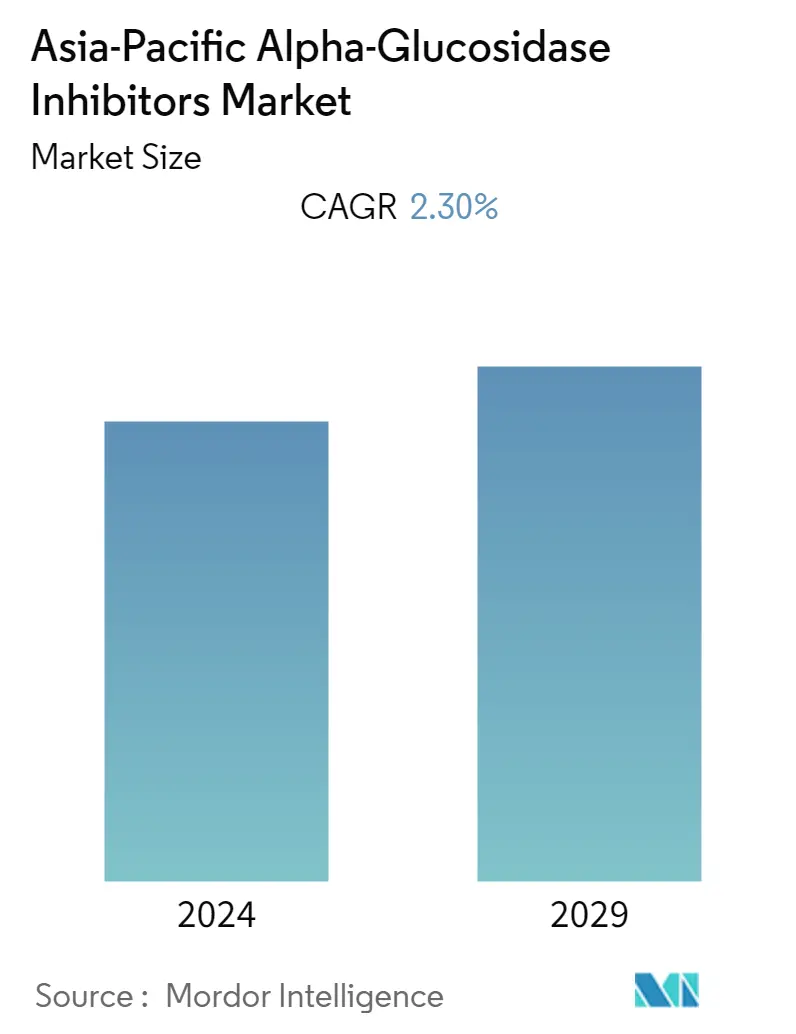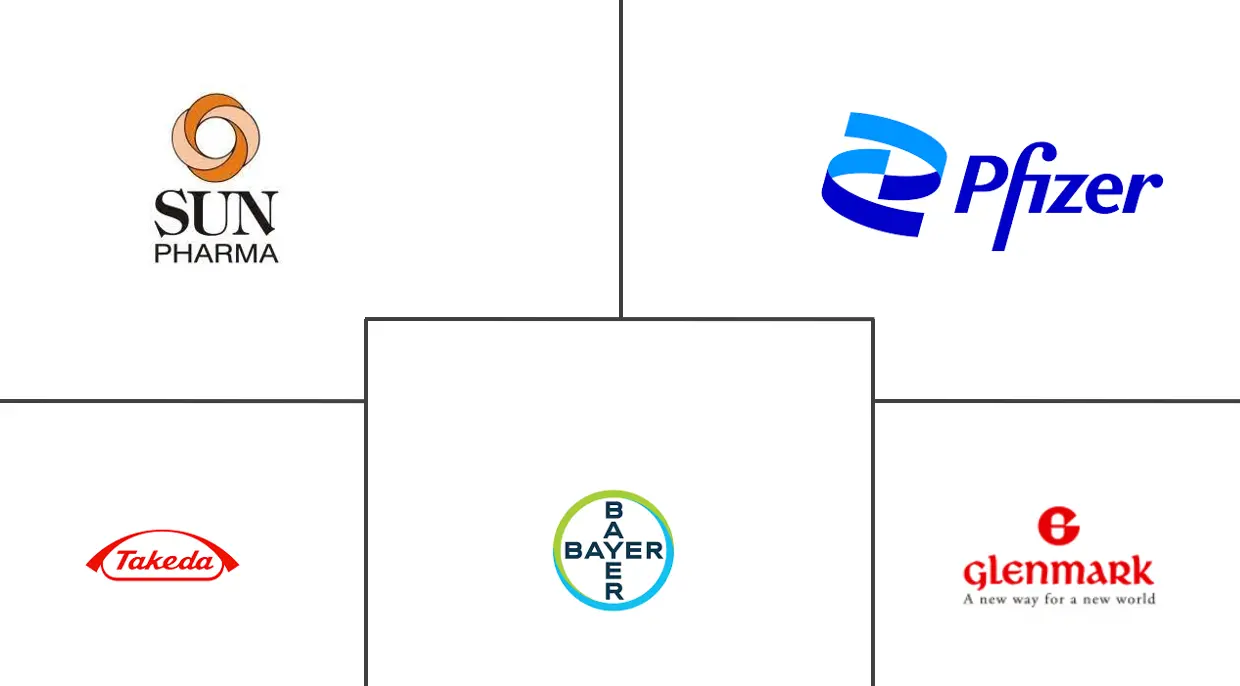Market Size of Asia-Pacific Alpha-Glucosidase Inhibitors Industry

| Study Period | 2018 - 2029 |
| Base Year For Estimation | 2023 |
| Forecast Data Period | 2024 - 2029 |
| Historical Data Period | 2018 - 2022 |
| CAGR | 2.30 % |
Major Players
*Disclaimer: Major Players sorted in no particular order |
Asia-Pacific Alpha-Glucosidase Inhibitors Market Analysis
The Asia-Pacific Alpha-Glucosidase Inhibitors Market size is estimated at USD 4.14 billion in current year, and is expected to reach USD 4.64 billion by forecast year, growing at a CAGR of 2.30% during the forecast period.
People with Covid-19 had a statistically greater incidence of type 2 diabetes and other kinds of diabetes in the Asia-Pacific region. Individuals with no history of diabetes who recovered from SARS-CoV-2 infections have been reported to develop insulin resistance and reduced insulin secretion. It has been proposed that integrated rather than disease-specific methods are needed for post-Covid syndrome diagnosis and therapy.
Alpha-glucosidase inhibitors (AGIs) are a class of diabetes medications used to treat type 2 diabetes. This activity covers the indications, mechanism of action, contraindications, adverse effects, monitoring, and other critical elements needed by healthcare professionals involved in the management of type 2 diabetes mellitus and its complications. Although alpha-glucosidase inhibitors have been studied as monotherapy and as part of a combination regimen for the treatment of diabetes, they are not considered standard first-line therapy due to their low efficacy and poor tolerance. If the gastrointestinal side effects are tolerated, they may play a role as part of a combination regimen in people who consume high-carbohydrate diets and have high postprandial glucose levels.
This is driving the demand for Alpha-Glucosidase Inhibitors Market in Asia-Pacific, thereby driving the market in focus during the forecast period.
Asia-Pacific Alpha-Glucosidase Inhibitors Industry Segmentation
Alpha-glucosidase inhibitors prevent the small intestine from absorbing carbs. By competitive inhibition, they block enzymes that convert complicated non-absorbable carbs into simple, absorbable carbohydrates. Glucoamylase, sucrase, maltase, and isomaltase are some of these enzymes. The Asia-Pacific Alpha-Glucosidase Inhibitors Market is segmented by geography (Japan, China, South Korea, India, Australia, Vietnam, Malaysia, Indonesia, Philippines, Thailand, and the rest of Asia-Pacific). The report offers the value (in USD) and volume (in units) for the above segments. We will provide a segment-wise breakdown (value and volume) for all the countries covered under the Table of Contents.
| Drug | |
| Alpha-glucosidase Inhibitors |
| Geography | |
| Japan | |
| China | |
| South Korea | |
| India | |
| Australia | |
| Malaysia | |
| Indonesia | |
| Philippines | |
| Thailand | |
| Rest of Asia-Pacific |
Asia-Pacific Alpha-Glucosidase Inhibitors Market Size Summary
The Asia-Pacific alpha-glucosidase inhibitors market is experiencing growth driven by the increasing prevalence of diabetes, particularly type 2 diabetes, in the region. This rise in diabetes cases is partly attributed to the post-Covid-19 syndrome, where individuals recovering from SARS-CoV-2 infections have shown a tendency to develop insulin resistance and reduced insulin secretion. Alpha-glucosidase inhibitors, which are used to manage postprandial blood glucose levels, are gaining traction as part of combination regimens, especially for patients with high-carbohydrate diets. Despite not being the first-line therapy due to their gastrointestinal side effects, these inhibitors are valuable for patients who do not experience adverse effects and require additional support in managing their blood glucose levels.
China stands out as a significant market within the Asia-Pacific region, driven by its large diabetic population and a growing preference for oral anti-diabetics. The market is characterized by intense competition, with both global and regional players like Bayer, SunPharma, Pfizer, and Takeda actively participating. The presence of numerous generic products, particularly in China and India, contributes to the region's leading market share. The inhibitors, such as acarbose, miglitol, and voglibose, are extensively studied and used to improve metabolic profiles and reduce the risk of long-term complications in diabetes patients. The market's growth is supported by ongoing research and regulatory developments, such as drug repurposing studies and price regulation efforts, which aim to make these treatments more accessible.
Asia-Pacific Alpha-Glucosidase Inhibitors Market Size - Table of Contents
-
1. MARKET DYNAMICS
-
1.1 Market Overview
-
1.2 Drivers
-
1.3 Restraints
-
1.4 Porter's Five Forces Analysis
-
1.4.1 Bargaining Power of Suppliers
-
1.4.2 Bargaining Power of Consumers
-
1.4.3 Threat of New Entrants
-
1.4.4 Threat of Substitute Products and Services
-
1.4.5 Intensity of Competitive Rivalry
-
-
-
2. Market Segmentation
-
2.1 Drug
-
2.1.1 Alpha-glucosidase Inhibitors
-
-
2.2 Geography
-
2.2.1 Japan
-
2.2.2 China
-
2.2.3 South Korea
-
2.2.4 India
-
2.2.5 Australia
-
2.2.6 Malaysia
-
2.2.7 Indonesia
-
2.2.8 Philippines
-
2.2.9 Thailand
-
2.2.10 Rest of Asia-Pacific
-
-
Asia-Pacific Alpha-Glucosidase Inhibitors Market Size FAQs
What is the current Asia-Pacific Alpha-Glucosidase Inhibitors Market size?
The Asia-Pacific Alpha-Glucosidase Inhibitors Market is projected to register a CAGR of 2.30% during the forecast period (2024-2029)
Who are the key players in Asia-Pacific Alpha-Glucosidase Inhibitors Market?
Takeda, Pfizer, Bayer, Sun Pharma and Glenmark are the major companies operating in the Asia-Pacific Alpha-Glucosidase Inhibitors Market.

